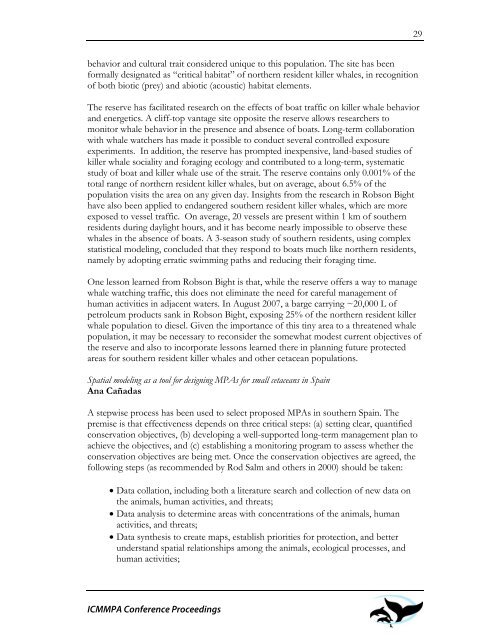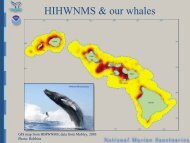The First International Conference on Marine Mammal Protected Areas
The First International Conference on Marine Mammal Protected Areas
The First International Conference on Marine Mammal Protected Areas
Create successful ePaper yourself
Turn your PDF publications into a flip-book with our unique Google optimized e-Paper software.
ehavior and cultural trait c<strong>on</strong>sidered unique to this populati<strong>on</strong>. <str<strong>on</strong>g>The</str<strong>on</strong>g> site has been<br />
formally designated as “critical habitat” of northern resident killer whales, in recogniti<strong>on</strong><br />
of both biotic (prey) and abiotic (acoustic) habitat elements.<br />
<str<strong>on</strong>g>The</str<strong>on</strong>g> reserve has facilitated research <strong>on</strong> the effects of boat traffic <strong>on</strong> killer whale behavior<br />
and energetics. A cliff-top vantage site opposite the reserve allows researchers to<br />
m<strong>on</strong>itor whale behavior in the presence and absence of boats. L<strong>on</strong>g-term collaborati<strong>on</strong><br />
with whale watchers has made it possible to c<strong>on</strong>duct several c<strong>on</strong>trolled exposure<br />
experiments. In additi<strong>on</strong>, the reserve has prompted inexpensive, land-based studies of<br />
killer whale sociality and foraging ecology and c<strong>on</strong>tributed to a l<strong>on</strong>g-term, systematic<br />
study of boat and killer whale use of the strait. <str<strong>on</strong>g>The</str<strong>on</strong>g> reserve c<strong>on</strong>tains <strong>on</strong>ly 0.001% of the<br />
total range of northern resident killer whales, but <strong>on</strong> average, about 6.5% of the<br />
populati<strong>on</strong> visits the area <strong>on</strong> any given day. Insights from the research in Robs<strong>on</strong> Bight<br />
have also been applied to endangered southern resident killer whales, which are more<br />
exposed to vessel traffic. On average, 20 vessels are present within 1 km of southern<br />
residents during daylight hours, and it has become nearly impossible to observe these<br />
whales in the absence of boats. A 3-seas<strong>on</strong> study of southern residents, using complex<br />
statistical modeling, c<strong>on</strong>cluded that they resp<strong>on</strong>d to boats much like northern residents,<br />
namely by adopting erratic swimming paths and reducing their foraging time.<br />
One less<strong>on</strong> learned from Robs<strong>on</strong> Bight is that, while the reserve offers a way to manage<br />
whale watching traffic, this does not eliminate the need for careful management of<br />
human activities in adjacent waters. In August 2007, a barge carrying ~20,000 L of<br />
petroleum products sank in Robs<strong>on</strong> Bight, exposing 25% of the northern resident killer<br />
whale populati<strong>on</strong> to diesel. Given the importance of this tiny area to a threatened whale<br />
populati<strong>on</strong>, it may be necessary to rec<strong>on</strong>sider the somewhat modest current objectives of<br />
the reserve and also to incorporate less<strong>on</strong>s learned there in planning future protected<br />
areas for southern resident killer whales and other cetacean populati<strong>on</strong>s.<br />
Spatial modeling as a tool for designing MPAs for small cetaceans in Spain<br />
Ana Cañadas<br />
A stepwise process has been used to select proposed MPAs in southern Spain. <str<strong>on</strong>g>The</str<strong>on</strong>g><br />
premise is that effectiveness depends <strong>on</strong> three critical steps: (a) setting clear, quantified<br />
c<strong>on</strong>servati<strong>on</strong> objectives, (b) developing a well-supported l<strong>on</strong>g-term management plan to<br />
achieve the objectives, and (c) establishing a m<strong>on</strong>itoring program to assess whether the<br />
c<strong>on</strong>servati<strong>on</strong> objectives are being met. Once the c<strong>on</strong>servati<strong>on</strong> objectives are agreed, the<br />
following steps (as recommended by Rod Salm and others in 2000) should be taken:<br />
• Data collati<strong>on</strong>, including both a literature search and collecti<strong>on</strong> of new data <strong>on</strong><br />
the animals, human activities, and threats;<br />
• Data analysis to determine areas with c<strong>on</strong>centrati<strong>on</strong>s of the animals, human<br />
activities, and threats;<br />
• Data synthesis to create maps, establish priorities for protecti<strong>on</strong>, and better<br />
understand spatial relati<strong>on</strong>ships am<strong>on</strong>g the animals, ecological processes, and<br />
human activities;<br />
ICMMPA <str<strong>on</strong>g>C<strong>on</strong>ference</str<strong>on</strong>g> Proceedings<br />
29



